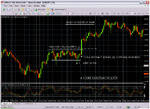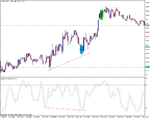What Triggers do you use to Enter a Trade?
LONG ANSWER
TA based triggers
Most trade entry triggers are based on Technical Analysis (TA) or Fundamental Analysis (FA). Traders who employ strategies based on TA tend to use the breach of an important price level to trigger their trade entries. These include (but are not limited to) things like a breach of a high or low of a specific bar or candle, or a key level of support or resistance.
FA based triggers
Traders who employ strategies based on FA will enter trades based on things like earnings announcements or other key data that is likely to impact their market and the price of their chosen instrument(s). It might be something as simple as an article in a newspaper, as in the following example, quoted from Peter Navarro’s book ‘If it’s Raining in Brazil, Buy Starbucks’:
“Despite excellent management and a solid fundament outlook, Starbucks’s stock has dropped more than 8 dollars in the last several months. At this point, the savvy investor notices a small article on the back pages of the Wall Street Journal (WSJ) indicating that the rains have come to break a deadly drought in Brazil – the world’s largest coffee producing nation.
On this news, the savvy investor buys several thousand shares of Starbucks. She’s betting that the rains will save the Brazilian coffee crop, that this will cause coffee prices to fall dramatically, and that this, in turn, will drive up Starbucks’s profit margins as well as its share price.
Over the next week, Starbucks’s stock falls 2 more dollars, but the investor sits tight. Finally, the stock begins to rise – and quickly – ten dollars in just three days. She sells her shares and is out with an $8,000 profit.”
Mix ‘n match
As a generalisation, it’s true to say that - in the past - traders have tended to be either in the TA camp or the FA camp. Additionally, the shorter their preferred timeframe; the greater their use and dependency on TA. These days, increasingly, traders are utilising a mix of the two disciplines. In the quote above, the savvy investor spots an opportunity and uses the WSJ article as the trigger to enter her trade. However, initially, the stock continued to fall and, at one point, she was $2,000 ‘offside’. (I.e. if she had sold her shares, her paper loss would have become all too real and she would have been $2,000 out of pocket.) If she was familiar with some simple reversal patterns then, in theory, she could have waited until the stock changed direction and entered at a more optimal price, based on a TA trigger. In so doing, she would have enjoyed a bigger profit and would not have had to weather the $2,000 paper loss. The basic concept of her trade was sound but, arguably, the timing of its execution left a little to be desired.
Listing all the entry triggers that traders use in this FAQ would take forever and make for rather dull reading. Instead, this FAQ will focus on the kinds of things that members would do well to consider when creating entry triggers of their own, that are best suited to their trading style and time frame. For anyone wanting examples of specific entry triggers - please refer to the threads listed in post #3 entitled ‘Useful Links’.
Trade set ups
Before going any further, there is one very important issue to address first, and that is the trade set up. Just as one wouldn’t squeeze the trigger on a riffle without first positioning oneself carefully and then taking aim; to focus on the entry trigger without first considering the set up would be putting the cart before the horse. A set up can be defined as a confluence of TA patterns or FA events which must occur first in order to validate any subsequent entry trigger. If a valid set up does not precede the entry trigger, then the proposed trade should not be taken. Likewise, trades should not be entered on the basis of the set up alone; a valid entry trigger must also ensue. For the ‘savvy investor’ above, the WSJ article could (and, arguably, should) have been considered as a set up only – rather than an entry trigger.
Entry triggers: 5 key characteristics
Here are 5 key characteristics to keep in mind when devising your own entry triggers, many of which are equally applicable to trade set ups . . .
• Keep it simple
This is really important – especially for day traders. Your set ups and entry triggers need to be simple, unambiguous and crystal clear so that you can spot them easily in real time and make an instant decision that’s in keeping with your trading plan. If you look over old trades and conclude that they’re invalid because the set up and/or entry don’t meet your criteria, then the cause is likely to be that they’re too complicated or not sufficiently black and white.
• Timing
Like great comedy, central to a good entry trigger is great timing. At some point or another, virtually all traders have analysed the markets correctly and got its basic direction right, but completely fluffed the timing of their entry. Get into a trade too late and you run the risk of ‘chasing the market’. Typically, it becomes temporarily overbought and you buy just ahead of a pullback which stops you out. Price then resumes its original direction, shooting past your entry level. Conversely, get in too soon and you run the risk of ‘trying to catch a falling knife’. Price then either reverses after having stopped you out, or, what you imagined would develop into a full blown reversal pattern turns out to be a simple continuation pattern instead. These are easy mistakes to make and are often very difficult to avoid. That said, ideally, a good entry trigger will have a failsafe facility that will, hopefully, keep you out of trades that you don’t want to be in.
• The Exit
There are a number of debates that rumble on and on about which traders never seem to agree. High on this list is the argument about trade entries and exits: which one is most important? We won’t discuss this here, save to say that there is an old adage to the effect: ‘entries define risk and exits define reward’. For many traders, risk trumps reward. However, that’s not to say that exits aren't of critical importance. Central to this is knowing where you’ll close out the trade it goes against you. If your exit is too close to your entry trigger, you run the risk of being stopped out by market ‘noise’ during volatile periods. Conversely, if it’s too far away, this might involve taking on too much risk. A good entry can’t be viewed in isolation; it needs to be viewed in the context of the exit as well.
• Profit Targets
Is there a realistic and probable expectation of the trade going into profit? Lots of traders don’t believe in profit targets as this is akin to trying to predict the future. This is fair enough, although some common sense can still be applied. Suppose you’re an equities day trader and your chosen stock has an average daily range of $2.00 and it’s up $1.75 on the day. Furthermore, it’s Friday and the markets close in half an hour. Is it really wise to enter long at this point, knowing that the stock is unlikely to rise much more and that it’s common to see some profit taking at that time of the day? Under these circumstances, the probability of the trade working out isn’t too great. To use a driving analogy, think of entering a trade like overtaking a car on a straight road with oncoming traffic in the distance. The speed you’re travelling at, the distance between you and the oncoming traffic, along with their speed, all need to be weighed up in an instant. If in doubt, sit on your hands. Anything other than a high probability trade is, by default, a low probability one.
• Context
To sum up all the above four points, context is king. This is so important, it’s worth shouting about: CONTEXT IS KING! The perfect set up can appear, followed by the perfect entry trigger, but is the context perfect too? Suppose the instrument is well up on the day and has already moved 90% of its average daily range. Additionally, there’s known resistance immediately overhead, indicators are in overbought territory, news is bearish, there’s a major announcement due out in five minutes from the chairman of the Federal Reserve and the longer term trend is down. Do you still want to enter long? Do you, do you really? Assessing the context of any proposed trade is a major advantage that discretionary traders have over mechanical traders. It also accounts for why so many TA patterns fail. Context is king and being able to evaluate it quickly and effectively is often central to a discretionary trader’s edge and the difference between their account showing a profit instead of a loss.



